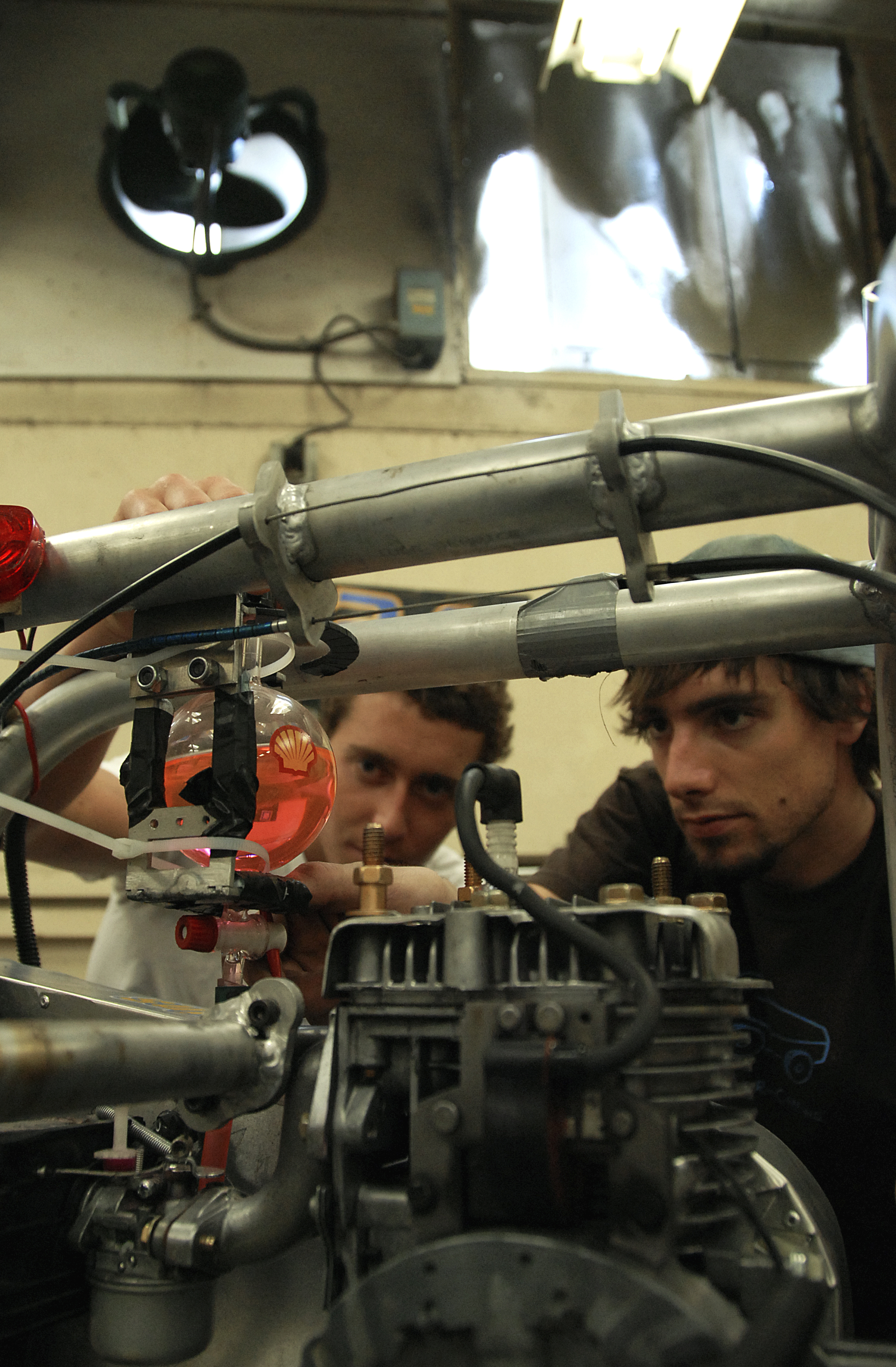Room 2033 of the Engineering I building contains an intricate arrangement of tools, scrap metal and bike parts, as well as skeletons of several vehicles.
This is the home of the Supermileage Vehicle Team, an on-campus club that dedicates its time to producing the most fuel-efficient vehicle possible, capable of surpassing 1,000 mpg.
The room is in disarray before the team’s biggest competition of the year, the Annual Society of Automotive Engineers Competition, which will take place on June 4 and 5. Many last-minute modifications must be made.
The vehicle the team is working on weighs a scant 110 pounds and fits one person lying down. Its incredibly high fuel efficiency is achieved only within the supervised domain of a track and will never be seen alongside more familiar vehicles.
“It’s on the extreme end of minimalism and luxury,” said Jordan Chase, project leader and a third-year mechanical engineering student.
On competition days, the group must first pass a rigorous safety inspection before being allowed to complete runs on the course at their convenience. The miniscule 250 ml gas tank is measured before and after the race to determine how much gas has been burned and to calculate its fuel efficiency.
Competition days can be hectic, Chase said. At the Shell Eco-marathon, their last event, the team logged 500 mpg on their first run.
That night, the team members stayed up until 3 a.m. fine-tuning their vehicle. The small changes made a difference, and the next day they logged a run with 1,239.5 mpg, reaching their goal of surpassing 1,000 mpg.
Chase said he has been involved in the team since his freshman year, and for three years has been tackling the three basic problems of the supermileage vehicle: weight, aerodynamics and rolling resistance ““ essentially friction.
The majority of the team’s time is spent forming the protective hull of the vehicle, called the fairing, Chase said. Made of lightweight carbon fiber and resin, it has a smooth finish to reduce drag. The fairing requires at least 100 man hours to create, and each mold takes the team several weeks to finish.
“All your time and money goes into your mold work, because your finished product is only going to be as good as your mold,” Chase said.
No detail is too small to overlook, he said. The team even tries to limit welding on the chassis, the skeleton of the vehicle and its basic structural support, because welding reduces strength.
Funding can also be a problem at times, as the team receives no funding from the school and must raise money from outside sources, said Philippe Gerretsen, assistant project manager and fourth-year mechanical engineering student.
Gerretsen said the team takes material contributions and reuses what they can. He added that their parents chip in on occasion.
Tony Pereira, a graduate student of mechanical engineering who has known the team since its infancy, said that the supermileage vehicle has certain limitations. It is not a car, which is a specific type of vehicle that has passed government standards for safety and can be driven on a road.
“You’re never going to go to a car salesman and buy the supermileage vehicle,” Pereira said.
The supermileage vehicle is an ideal that can never be fully realized in a form that can be marketed to consumers, but it is a prototype to show what can be done, Gerretsen said.
For example, the vehicle resembles a drop of water as it falls through sky, and it was designed on a drafting program to be as streamlined and aerodynamic as possible, Gerretsen said. Vehicles like the Prius also make efforts to improve fuel efficiency using similar methods, he added.
“It’s all about reducing that cross-sectional area and getting air over it, versus something like a Hummer, which has a block base pushing against air, making more work for the engine,” Chase said.
The cost of the vehicle’s minimal and efficient design is safety, he said.
“There’s not a lot of active safety features, besides a crumple zone and a roll bar, basic structural things that protect the driver,” he said.
“No air bags, anti-lock breaking system. There’s no OnStar. But obviously there’s a huge margin to work with between 1,200 miles a gallon and 25 miles a gallon.”
While Chase and Gerretsen are both engineers, they made it clear any students of any field of study can contribute to the Supermileage Vehicle Team.
“We learned it from experience,” Chase said. “There’s no class you can take that will teach you how to build this.”
Motivation is the only necessary quality to join the team.
“We can teach them the hard skills; all they need are the soft skills of wanting to be here, wanting to learn something new, wanting to learn with their hands, and having an appreciation for fuel efficiency,” Chase said.
“Come down to shop hours,” said Gerretsen. “At the beginning of the year we have a lot of work to be done.”
